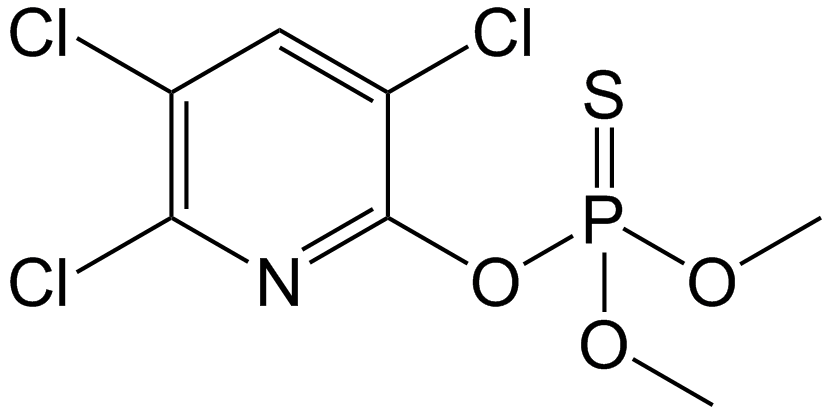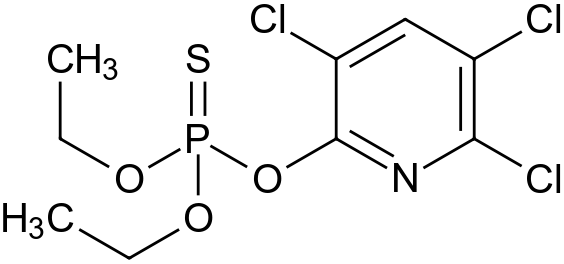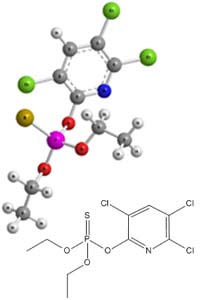Chlorpyrifos
O, O -diethyl- O-( 3,5,6- trichloropyridin- 2-yl) - thiophosphate
Colorless crystals
Fixed
42 ° C
Slightly soluble in water: 1.4 mg · L-1 (25 ° C)
Risk
60 mg · kg -1 ( LD50, mouse, oral)
Template: Infobox chemical / molecular formula search available
Chlorpyrifos is a Thiophosphoric, which was introduced as an insecticide from Dow Chemical Co. in the mid -1960s. Trade names include Dursban, Empire, Eradex, Lorsban (Dow Chemical Company), Pyrinex and Stipend.
Effect
Chlorpyrifos has contact, feeding and respiratory toxicity. It acts on the nervous system of insects by inhibiting the enzyme acetylcholinesterase.
Application
Chlorpyrifos is widely used against sucking and biting insects as well as against soil pests in many agricultural crops, against ants in the house and garden, against house flies, household and storage pests against clothes moths, for mosquito control, as a stable spray and for controlling ectoparasites on animals.
Regulation
EU
In the European Union since 2005 is considered an admission of this active substance for plant protection products. The currently valid authorization will expire on January 31, 2018. At the national level it has been approved in 22 EU countries. The Permitted daily dose is 0.01, the Acute Reference Dose 0.1 and the Acceptable Operator Exposure 0.01 milligrams per kilogram of body weight per day.
In Germany two preparations for use in vegetable production and to combat path and lawn ant are allowed. In Austria and Switzerland chlorpyrifoshaltige products for a variety of applications in farming, fruit growing and viticulture and forestry are allowed.
USA
In the U.S. this means is prohibited since 2001 for domestic use is agriculture but allowed.
Toxicology
Symptoms of poisoning are similar to those of other inhibitors of cholinesterases: There occur among others colic, nausea, diarrhea and vomiting, dizziness, headache, blurred vision ( accommodation disorder ), contracted and non-reactive pupils ( miosis ), bradycardia, hypotension, to convulsions and respiratory arrest. Chlorpyrifos is contaminated with O, O, O, O- tetraethyl dithiopyrophosphat ( Sulfotep ), which is considered of toxicological concern. The maximum level of Sulfotep was set by the EU at 3 g / kg of chlorpyrifos.
In children who were exposed in the womb subtoxic doses of chlorpyrifos, morphological changes of the cerebral cortex, including gender- typical characteristics, as well as impairment of mental ability were found.
Studies in the U.S. showed that could be detected in the same neighborhoods in New York before the ban chlorpyrifos in indoor air of almost all tested and apartments in the blood of the majority of African-American mothers. It was also shown that the body found by children chlorpyrifos values decreased drastically after the diet of the children had been converted from conventional to organic products.










